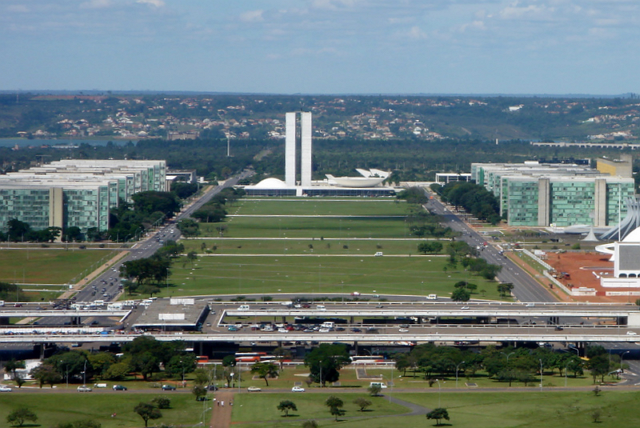Brasilia, The Futuristic Capital - by Travel Deeper Brazil
A little more about Brasilia
Renowned for its modernist lines and futuristic design, Brasilia is a study in urban planning and the only city built in the 20th century to be counted among UNESCO's World Heritage Sites. Where only five years before its inception there was desert, now there are innovative buildings and imaginative monuments, ranging from the hyperboloid Cathedral of Brasilia to the lunar-esque Complexo Cultural da Republica to the glass-box Palacio da Alvorada. Source: http://www.tripadvisor.com/Tourism-g303322-Brasilia_Federal_District-Vacations.html
Laid out along a monumental east-west axis, crossed by a north-south axis curved to follow the topography as a transportation thoroughfare, Brasilia is a definitive example of 20th century modernist urbanism. Created as the Brazilian capital in the central western part of the country from 1956 to 1960 as part of President Juscelino Kubitschek’s national modernization project, the city brought together ideas of grand administrative centres and public spaces with new ideas of urban living as promoted by Le Corbusier in six storey housing blocks (quadras) supported on pylons which allowed the landscape to flow beneath and around them. The city’s planning is noteworthy for the remarkable congruence of Lucio Costa’s urban design (the ‘Plano Piloto’) and Oscar Niemeyer’s architectural creations, most powerfully reflected in the intersection between the monumental and thoroughfare axes, which stands as the determining factor of the city’s urban scheme and underscores the representative character of Three Powers Square (Praça dos Três Poderes) and the Esplanade of the Ministries (Esplanada dos Ministérios), also manifest in the geometry of the National Congress and in the new approach to urban living embodied in the Neighborhood Units (Unidade de Vizinhança) and their corresponding Superblocks (Superquadras).
Source:
https://commons.wikimedia.org/wiki/File:BrasiliaBanNacional.jpg
Brasilia is a singular artistic achievement, a prime creation of the human genius, representing, on an urban scale, the living expression of the principles and ideals advanced by the Modernist Movement and effectively embodied in the Tropics through the urban and architectural planning of Lucio Costa and Oscar Niemeyer. The Brazilian experience is notable for the grandiosity of the project, one which not only brought to a definitive close a particular historical epoch, but which was closely tied to an ambitious development strategy and to a process of national self-affirmation before the world.
Source: https://commons.wikimedia.org/wiki/File:Brazil.Brasilia.01.jpg
Brasilia is a unique example of urban planning brought to fruition in the 20th century, an expression of the urban principles of the Modernist Movement as set out in the 1943 Athens Charter, in Le Corbusier’s 1946 treatise How to Conceive Urbanism, and in the architectural designs of Oscar Niemeyer, including the buildings of the three powers (Presidential Palace, Supreme Court and Congress with its twin highrise buildings flanked by the cupola of the Senate building and by the inverted one of the House of Representatives), and the Cathedral with its 16 paraboloids 40 metres in height, the Pantheon of Juscelino Kubitschek and the National Theatre.
Source: https://commons.wikimedia.org/wiki/File:28_12_05_010_zoom_approach_Ponte_JK.jpg
The urban framework of Brasilia includes all of the elements required to demonstrate outstanding universal value. A city that is at once urbs and civitas, Brasilia has preserved its original guiding principles intact, as reflected in the protection of its urban scales, legally protected by local and federal organisms of government of the country.
The city finds itself today in the midst of a process of consolidation, in accordance with its dual function as city and capital, through the continuing implementation of new urban services and structures.
Source: https://commons.wikimedia.org/wiki/File:Memorial_JK.jpeg
The authenticity of Brasilia is guaranteed through maintenance of its architecture, urban design, and landscapes, all of which represent a new approach to urban living, reaffirmed by Lucio Costa and Oscar Niemeyer on the basis of the Modernist Movement’s principles for 20th century architecture and urbanism.
The primary attributes of the Pilot Project (Plano Piloto) which converge to attribute universal and outstanding value to Brasilia include: the intersection of two axes and the hierarchical distribution of the road system, the division of the city into sectors with their respective characteristics and end uses, the network of open and green spaces, the Esplanade of the Ministries and representative structures that make up the Monumental Axis (Eixo Monumental), the superblocks organized on the basis of neighborhood units, and, lastly, Oscar Niemeyer’s architectural designs of the key representative buildings.
Source: http://whc.unesco.org/en/list/445/
